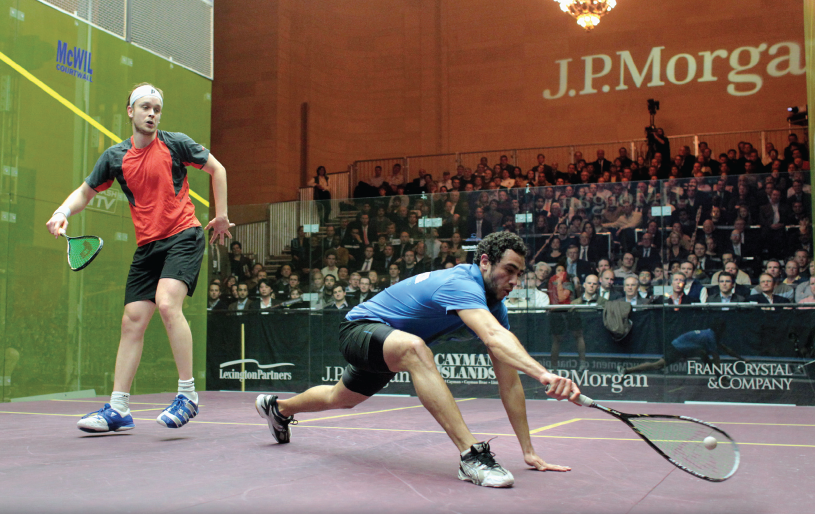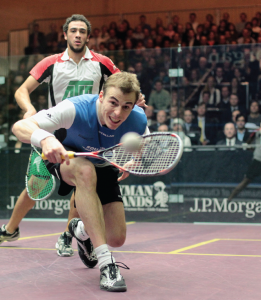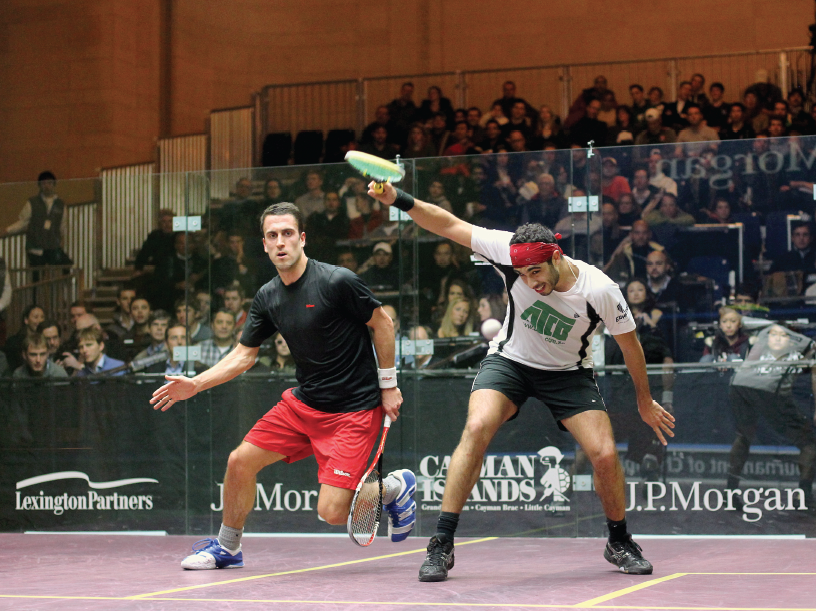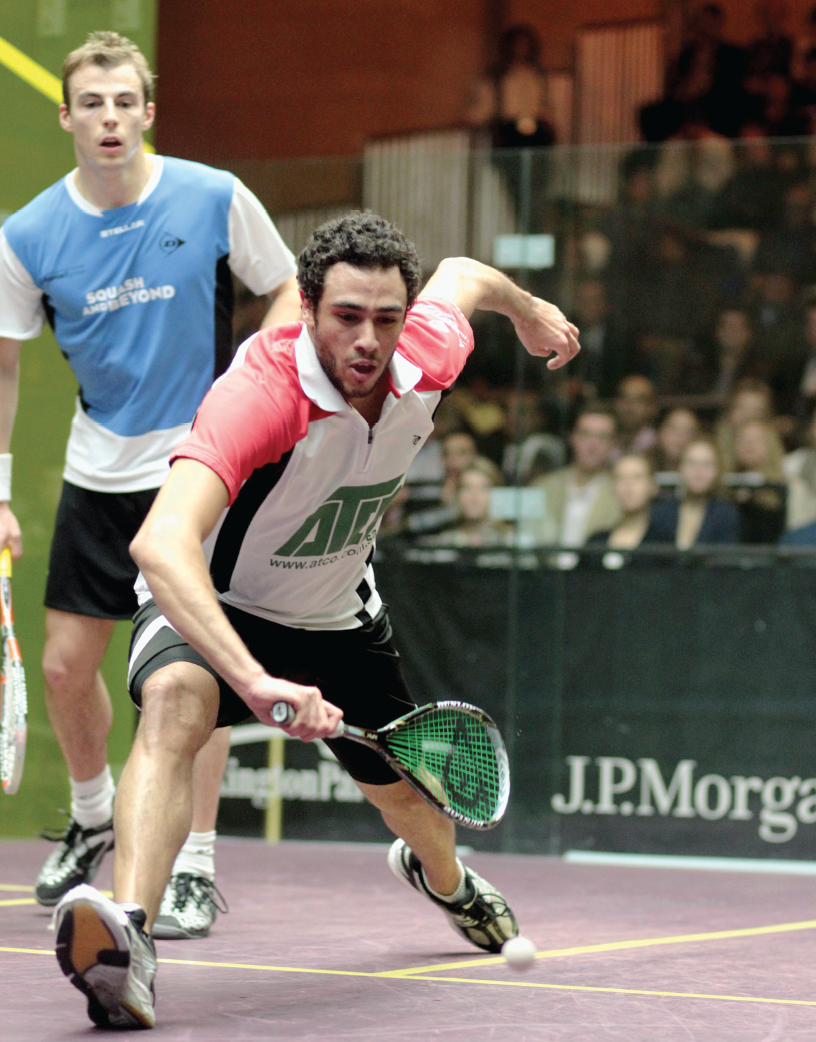
By James Zug
Photos by Steve Line/SquashPics.com
Ramy Ashour won the 2011 J.P. Morgan Tournament of Champions, but it was his older compatriot, Amr Shabana, who stole the show in his epic semifinal loss to Nick Matthew.
The Prince of Cairo, Shabana is called. He is royalty, but I prefer the nom de plume The Egyptian Magician. He has a very ancient-looking face, not old, but wise, all-knowing, the clean curve of the nose and cheekbones, the bald pate, the expressive eyebrows, the bright, fierce, searching eyes that could be very brown if they tried. He knows how to pull rabbits out of hats.
This ToC might have been his last major act. He’s still got the tattoos and swashbuckling gait and the unappeasable thirst for the cross-court nick, but you get the subtle sense that he is slowly easing his way off the stage. He’s turning 32 in July. He and his wife Najla have two young daughters. He’s been lately hanging around Brooklyn, looking at some teaching opportunities here in the States. He has been making a mark internationally since reaching the finals of the British Junior Open U14s in January 1993. He’s been a pro since he was 15. He’s played in 138 tournaments (26 titles—his first was in the summer of 1999 in Mexico).
Signs of decline? He was No. 1 in the world for 33 consecutive months, but since he lost that status in 2008 he’s not been back to the top—right now he’s No. 5. He has not won a tournament since snagging the World Open in November 2009. He keeps on losing to his successors. Since that World Open, he’s lost three straight to Ashour, three straight to Matthew and three straight to James Willstrop.

For such an instinctual player, he’s endured far longer than expected. Staying power was never particularly an Egyptian trait in squash. In the 1930s Amr Bey, the first great Egyptian, won everything for six years and then retired and disappeared. In the late 1940s Mahmoud El Karim won four British Opens in a row, ran into Hashim Khan and two years later was gone. In the late 1990s Ahmed Barrada was the sudden star at the pyramids at Giza, but he too quit in his prime.
Fifteen full years on tour and counting. Amr Shabana is still with us. I was talking with James Willstrop in Grand Central one evening during the tournament, and he commented about how it had gotten a little stale, being on tour, and it took a little extra effort to get up and maintain the passion. I asked him how long he’d been on tour. Oh, he said, about eight years.
Double that and you’ve basically got Shabana.
His match against Nick Matthew in the semis was a gem. In the modern era, the only ToC match that was better was the famous 2001 finals in which Peter Nicol outlasted Jonathon Power 15-9,15-12, 13-15, 13-15, 15-11. Matthew is the top dog at the moment, No. 1 in the rankings, world champion. Yes, he’s just a year and five days younger than Shabana, but he is on the ascendant and looking for more. He won the first two games 11-8, 11-4, in 16 and then nine minutes.
Looking beaten, Shabana revived himself. He stayed on the court after the second game, instead of slumping in the deep leather courtside Barcaloungers that for the 2011 ToC had replaced the folding metal chairs of old. In the third Shabana concocted a 11-7 scoreline.
In the fourth, he burst to a 5-1 lead but Matthew, plucky to the extreme, fought back. At 8-all, Shabana strained his knee when his foot gave way as he went for a drop shot. Instead of limping off the court, he shook off the injury (not even taking his allotted three-minute injury time) and started diving and hustling after balls. Matthew had two match balls at 10-9 and 12-11 but couldn’t convert. (On one ball, he was denied an obvious let.) Shabana was utterly fearless. On the first match ball, he cracked his service return into the front-side wall nick, going for a risky shot. Echt Shabana. He escaped 14-12, in a compelling 25 minutes.
In the fifth, Shabana had a slight lead at 6-4 and 7-5, but Matthew tied it back up and on they inched towards the climax, 7-all, 8-all, 9-all. At 10-9, Matthew’s third match point, Shabana again went for the winner off the serve and again survived. At 11-10, Matthew had his fourth match ball and a magical point ensued, with Shabana sending Matthew all over the court—at one juncture he had to slap the ball off the back wall in desperation. And then Matthew dinked a straight drop and clinched it. Eighty-eight minutes and full of the ebb and flow of a classic match Matthew promised he’d have enough gas in the tank for the finals. After the match, he tweeted: “Am hurting a little bit right now. But it’s a good hurt.” He also had motivation, as he’d never won in New York, the only gap besides Hong Kong in his glittering career. But the hurt was a bad hurt, and Ashour, with his mother in the audience for the first time since he was 18, took the finals in less than an hour.

Shabana has won four World Opens, in 2003, 2005, 2007 and 2009—and so following that odd pattern, I’d not bet against him in Rotterdam this November. Beyond that, it is anyone’s guess.”
“Please be upstanding,” asked Peter Nicol at the 2011 J.P. Morgan Tournament of Champions. The three-time champion was requesting the audience at the World Squash Awards dinner to give a standing ovation to the winners, but he could have also been encouraging the Americans in the draw.
Unlike previous years, they failed to make a deep impression. In the first round of the qualies, Todd Harrity nipped a game off Bradley Ball and lasted for 47 minutes; Chris Gordon also grabbed a game in his 49 minute-match; it took 54 minutes for Chris Ryder to dispose of Gilly Lane in three games. (The only notable North American result out of the qualies was Princeton senior Dave Letourneau winning one match and doing well in his second against World No.18 Hisham Ashour.) Julian Illingworth, the lone American in the main draw, faced David Palmer. Playing in his record thirteenth straight ToC, Palmer was always in control against a lackluster Illingworth. Halfway through each game, the score knotted (6-all in the first, 7-all in the second and 9-all in the third) before Palmer pulled away. Illingworth did impress the American audience, though, by wearing protective eye goggles—perhaps a first for ToC since the switch to softball in 1992?

For hometown fans, then, interest centered on the annual women’s early evening exhibitions that featured New Yorkers Olivia Blatchford and Amanda Sobhy, as well as Dipika Pallikal, Natalie Grinham and Vanessa Atkinson, and on the third annual ToC Pong. For six hours on the day of the finals, two ping pong tables graced the court and 64 players chopped, looped and smashed and raised money for Big Brothers Big Sisters NYC. “Ping-pong is the puppy dog of racquet sports,” said Andy Lippman, one of the founders of ToC Pong, but this dog had a lot of bark.
The weather was brutal at this year’s ToC, with blizzards and single digit temperatures and so while fans sipped rum from Puerto Rico, they pondered a trip to the Caymans. There was a raffle for a free trip to the 2011 Cayman Open, which was won by Sanjay Nayar. “When they announced the winner, I was hanging out at the bar with some friends and didn’t hear it,” remembered Nayar, the son of former national champion Anil Nayar. “My brother, who was at the other end of Vanderbilt Hall, called me on my cell. I started walking towards him and heard my name and was thinking, ‘What did I do?’ and looked for an exit.”
A few other good matches besides the semifinal masterpiece were played at the ToC. Hisham Ashour, having lost fourteen pounds in an effort to get slimmer and faster, qualified in and then had two straight five-gamers, coming from behind to knock off Cameron Pilley and then losing 11-2 in the fifth to Peter Barker. But all eight seeds made the quarters, so the usual ToC early-round upsets were absent.
It was fortuitious that the Shabana v. Matthew match came when it did. Testing the rhizomatic reach of the Internet, the ToC was very techy: there were official ToC blogs and Twitter feeds and retweeting and Facebooking. You could find clips of exciting points on YouTube. Most of all, you could watch the semis and finals for free on your computer.
In 1991 the ToC (then called the WPSA Championships) was held at the Winter Garden down at the southern end of Manhattan. After the tournament, Prime Network broadcasted a 90-minute, edited segment on the tournament. This was the first time that squash had been on a national television broadcast. Twenty years later and squash was finally live on national television. This time ESPN3, the live Internet sports network (founded in 2005 as ESPN360), broadcast the semis and finals. They used the images and commentary from the PSA SquashTV. Since the site is available in Australia, all across Europe, Brazil, Chile and the Middle East, nearly a billion people could have viewed the Shabana v. Matthew match.
It is not a perfected system yet. The images are fantastic—it is now easy to follow the ball and there are quick replays and crisp camera views from around the court. However, the PSA needs to take the next step and tee up the matches better: more statistics and more Up-Close-and-Personal foregrounding. Joey Barrington, as lead commentator, did 350 matches last year. Many were with Paul Johnson. They are very good at describing the action. But squash needs to appeal to the average, unknowledgable viewer and explain why this match is exciting: who these players are, their backgrounds, their stories.
Then everyone will know what squash fans knew that Wednesday night in January, that Shabana v. Matthew was a match for the ages.


